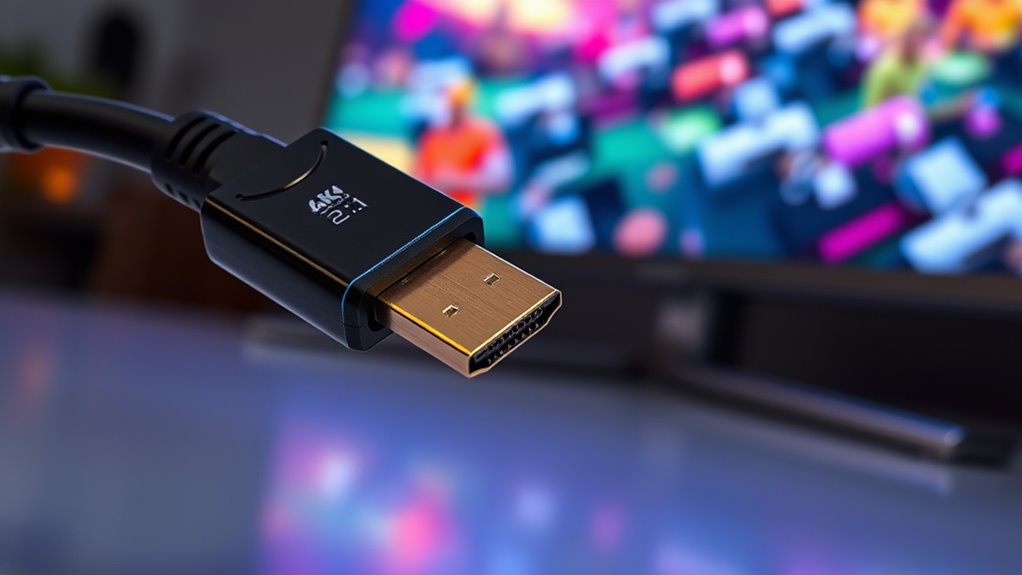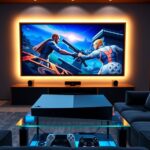HDMI 2.1 offers higher bandwidth up to 48 Gbps, supporting 8K at 60Hz and 4K at 120Hz, which means sharper images and smoother motion. Key features like Dynamic HDR, enhanced color depth, and motion smoothing improve visual quality, while eARC and high-quality cables guarantee better sound. Gaming benefits from VRR and ALLM, reducing lag and tearing. To get the most out of these features, focus on compatibility, cable quality, and your device settings. If you keep going, you’ll find exactly how to optimize your setup.
Key Takeaways
- Prioritize high-quality, certified “Ultra High Speed” HDMI 2.1 cables to ensure full feature support and reliable performance.
- Enable VRR and ALLM settings on compatible devices for smoother gaming and reduced input lag.
- Use devices with updated firmware to maximize compatibility, stability, and access to the latest features.
- Support for high resolutions (8K/4K at high refresh rates) and dynamic HDR enhances visual quality.
- Ensure proper cable management and signal quality to prevent interference and maintain optimal audio-visual performance.
Understanding HDMI 2.1 Bandwidth and Resolution Capabilities
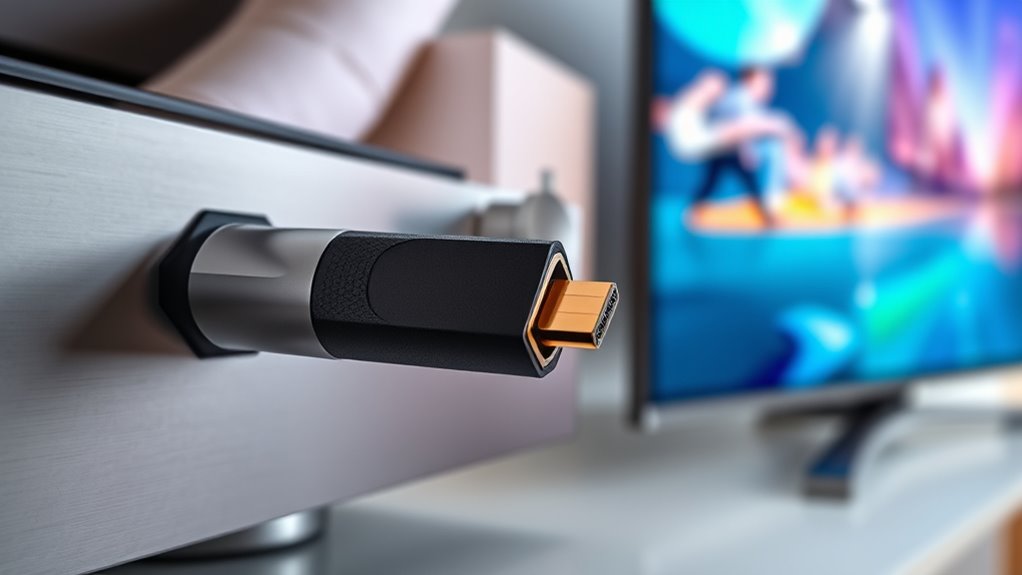
To fully appreciate HDMI 2.1’s capabilities, it’s essential to understand its increased bandwidth and how it impacts resolution support. HDMI 2.1 bandwidth is substantially higher than previous versions, reaching up to 48 Gbps. This boost allows you to transmit more data simultaneously, enabling higher resolutions and faster refresh rates. With this increased bandwidth, HDMI 2.1 supports resolutions up to 8K at 60Hz and 4K at 120Hz, delivering sharper images and smoother motion. These resolution capabilities mean you can enjoy ultra-high-definition content without compromising picture quality. The higher bandwidth guarantees compatibility with advanced gaming, immersive movies, and detailed professional work. Understanding this foundation helps you access the full potential of your HDMI 2.1-enabled devices, ensuring you experience the best possible picture quality. Additionally, high refresh rates supported by HDMI 2.1 are crucial for fluid motion in gaming and video playback.
The Significance of Dynamic HDR and Color Depth

Dynamic HDR and increased color depth boost the realism of your visuals, making scenes look more vibrant and true to life. They also require higher bandwidth, so your devices need to be compatible to handle the enhanced data. Understanding these features helps you optimize your setup for the best viewing experience. Additionally, advancements in generative AI are beginning to influence how content is created and rendered in media, further enhancing visual quality and interactivity.
Enhancing Visual Realism
Enhancing visual realism hinges on the ability of HDMI 2.1 to deliver richer images through features like Dynamic HDR and increased color depth. These improvements make colors more vibrant and details sharper, elevating your viewing experience. With better color grading, scenes appear more lifelike, and subtle shades become noticeable. Dynamic HDR adjusts scene-by-scene brightness and contrast, preventing washed-out or overly dark images. Meanwhile, higher color depth allows for smoother gradients, reducing banding. Features like motion smoothing work alongside these enhancements to create seamless motion, further immersing you in the content. When combined with proper bedroom decor, these technological advancements help create an environment that feels as immersive and comfortable as a cozy farmhouse retreat. Here’s how these features compare:
| Feature | Benefit |
|---|---|
| Dynamic HDR | Scene-by-scene brightness and contrast adjustments |
| Increased Color Depth | Smoother gradients, richer colors |
| Color Grading | Enhances realism by fine-tuning color accuracy |
| Motion Smoothing | Creates fluid motion, reducing blur |
| Overall Impact | More lifelike, immersive viewing experience |
Bandwidth and Compatibility
Bandwidth plays a vital role in supporting features like Dynamic HDR and increased color depth, as these enhancements demand higher data transfer rates for peak performance. Without sufficient bandwidth, you’ll experience reduced image quality or lag. When choosing cables, consider their durability—better-made cables withstand frequent use and bending, guaranteeing consistent performance. Compatibility is also crucial; not all brands’ cables support the latest HDMI 2.1 features, so verify brand compatibility to avoid issues. Higher bandwidth allows for smooth transmission of richer colors and dynamic metadata, releasing the full potential of your display. Additionally, understanding the signal quality required for high-quality transmission helps ensure your setup can handle these advanced features reliably, providing an optimal viewing experience without compromise.
Optimizing Refresh Rates for Gaming and Fast-Paced Content

To get the most out of your gaming and fast-paced content, optimizing your display’s refresh rate is essential. High refresh rates improve gaming performance by reducing motion blur and input lag, providing smoother visuals. To achieve ideal refresh rate settings, ensure your device supports HDMI 2.1 and enable variable refresh rate (VRR) if available. Adjust your monitor or TV settings to match the game’s native refresh rate, often 120Hz or higher. Use the table below to compare common refresh rates and their impact:
| Refresh Rate | Gaming Performance |
|---|---|
| 60Hz | Standard, smooth but less responsive |
| 120Hz | Better motion clarity, improved responsiveness |
| 144Hz+ | Superior for competitive gaming, minimal motion blur |
| 240Hz | Ultimate smoothness, high-end gaming setups |
Additionally, understanding industry trends can help you stay updated on the latest display technology improvements.
Key Audio Features: Earc and Enhanced Audio Return Channel
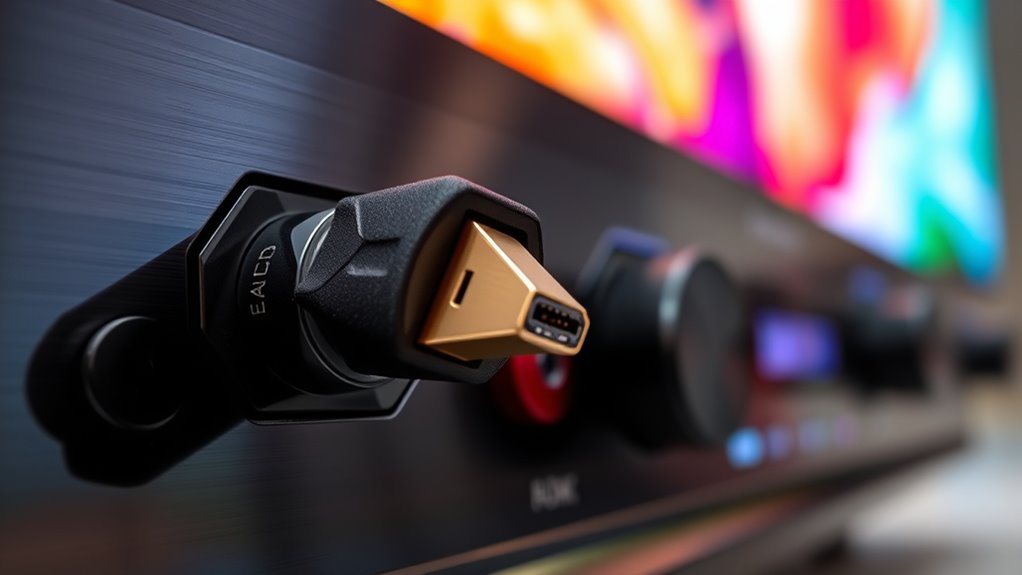
Earc compatibility lets you transmit high-quality audio directly from your TV to compatible sound systems, simplifying your setup. With enhanced sound quality, you’ll enjoy richer, clearer audio that matches your high-definition visuals. Understanding these features helps you get the most out of your home entertainment system. Additionally, being aware of privacy policies related to your devices ensures your audio and visual data are handled securely.
Earc Compatibility Benefits
Enhanced Audio Return Channel (eARC) offers significant benefits by streamlining how your devices handle high-quality audio. It ensures better audio synchronization, reducing delays between your TV and sound system. With eARC, you can enjoy uncompressed sound formats like Dolby Atmos and DTS:X without extra cables or adapters. This simplifies setup and improves overall experience. Additionally, eARC supports display calibration, enabling your TV and audio devices to work seamlessly for ideal picture and sound quality. Here’s a quick overview:
| Benefit | Description | Impact |
|---|---|---|
| Audio synchronization | Precise timing between video and sound | Clearer, more immersive |
| High-quality audio | Supports uncompressed formats | Superior sound fidelity |
| Simplified setup | Fewer cables, easier calibration | Faster, cleaner setup |
| Compatibility | Works across multiple devices | Versatile integration |
| Future-proofing | Ready for upcoming audio formats | Long-term value |
A wide range of devices can support eARC, making it a versatile choice for home entertainment systems.
Enhanced Sound Quality
Building on the advantages of eARC for seamless audio management, focusing on enhanced sound quality reveals even more benefits for your home entertainment setup. With HDMI 2.1, you can enjoy richer surround sound by supporting advanced audio formats like Dolby Atmos and DTS:X, delivering immersive audio experiences. Enhanced sound quality ensures your speakers reproduce audio more accurately, providing clearer dialogue and deeper bass. This means you get better fidelity and less compression, making movies, games, and music more vibrant. eARC also simplifies your setup by transmitting high-bandwidth audio without loss. Whether you’re upgrading your sound system or just want a more dynamic audio experience, HDMI 2.1’s enhanced sound features guarantee superior audio performance and compatibility with the latest surround sound formats. High-quality audio enhances your overall viewing experience by providing richer, more immersive sound.
Variable Refresh Rate (VRR) and Auto Low Latency Mode (ALLM) Explained

Variable Refresh Rate (VRR) and Auto Low Latency Mode (ALLM) are key features of HDMI 2.1 that enhance your gaming and viewing experience by reducing lag and screen tearing. VRR dynamically adjusts your display’s refresh rate to match your device’s frame rate, ensuring smoother gameplay and improved gaming enhancement. This eliminates stuttering and makes fast action scenes look more seamless. Additionally, proper calibration of these settings can further optimize your display performance. ALLM automatically switches your display to low latency mode when you start gaming, minimizing input lag for more responsive control. These features simplify display calibration, so you don’t need to manually tweak settings for peak performance. Together, VRR and ALLM create a more immersive, fluid experience, whether you’re gaming or enjoying fast-paced movies. They’re essential tools for maximizing your HDMI 2.1 setup’s potential.
Essential Cable and Device Compatibility Checks

To fully enjoy the benefits of HDMI 2.1 features like VRR and ALLM, you need to make certain your cables and devices are compatible. Start by checking the cable durability; only high-quality, certified HDMI 2.1 cables can handle the increased bandwidth and advanced features. Look for cables labeled as “Ultra High Speed” to ensure they meet the required standards. Device branding also matters—rely on reputable brands known for supporting HDMI 2.1 specs fully. Mismatched or uncertified cables may cause signal issues or limit feature performance. Verify your device specifications and confirm they explicitly support HDMI 2.1. Doing these checks upfront guarantees a seamless experience and prevents frustration down the line, ensuring you get the most out of your setup. Additionally, being aware of AI vulnerabilities in device security can help you stay informed about potential risks related to connected smart devices.
Practical Tips for Setting Up HDMI 2.1 for Maximum Performance
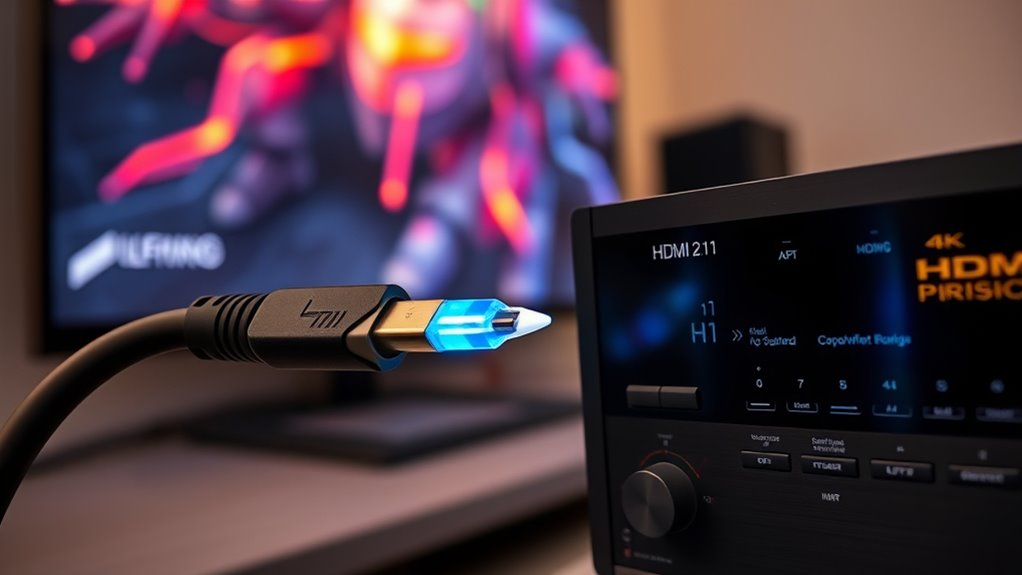
For ideal HDMI 2.1 performance, start by connecting your devices with high-quality, certified cables labeled as “Ultra High Speed.” Make sure your TV, gaming console, or PC are updated with the latest firmware, as updates often improve compatibility and stability. Proper cable management is essential; keep cables organized and avoid tangling to reduce interference and signal degradation. When setting up, focus on audio calibration to ensure excellent sound quality, adjusting settings for the best clarity and surround effects. Verify that your display settings support the full capabilities of HDMI 2.1, such as 4K at high refresh rates or enhanced audio formats. Additionally, considering the importance of security measures, ensure your home network is protected to prevent unauthorized access that could compromise your connected devices. These steps help maximize performance, delivering smoother visuals, richer sound, and an overall superior experience.
Frequently Asked Questions
How Do HDMI 2.1 Features Impact Gaming Console Performance?
HDMI 2.1 features substantially boost your gaming console performance by enabling higher frame rates and smoother gameplay. With VR gaming, the increased bandwidth reduces latency and guarantees clearer visuals, making immersive experiences more realistic. Frame rate optimization becomes easier, so you get fewer stutters and better responsiveness. Overall, HDMI 2.1 elevates your gaming, especially in fast-paced titles and VR, providing a more seamless and enjoyable experience.
Can Older Devices Be Upgraded to Support HDMI 2.1?
Older devices generally can’t be upgraded to support HDMI 2.1 because of hardware limitations. You might be able to update the device firmware, but this won’t add the necessary hardware features. To fully enjoy HDMI 2.1 benefits like higher bandwidth and advanced features, you’ll need a new device designed for HDMI 2.1 support. Upgrading hardware is usually the only way to access all its capabilities.
What Are the Cost Implications of HDMI 2.1-Compatible Equipment?
Thinking about upgrading? The cost analysis for HDMI 2.1-compatible equipment can be significant, so you should consider your budget considerations carefully. While prices have come down since the days of flip phones, high-quality HDMI 2.1 cables and devices still cost more than older tech. Expect to spend extra on new cables, consoles, or TVs, but weigh these costs against the enhanced features and future-proofing benefits HDMI 2.1 offers.
How Does HDMI 2.1 Affect Streaming Device Compatibility?
HDMI 2.1 improves streaming device compatibility by increasing HDMI bandwidth, allowing for higher resolutions and refresh rates. This means your devices can handle 4K or even 8K content seamlessly, guaranteeing better picture quality. It also enhances device interoperability, so your streaming setup works smoothly across different gadgets. Upgrading to HDMI 2.1 ensures your devices stay compatible with the latest content formats and future-proof your entertainment system.
Are There Any Security Concerns With HDMI 2.1 Features?
Yes, there are security concerns with HDMI 2.1 features. You should be aware of encryption vulnerabilities that could expose your data, especially during high-bandwidth transmissions. Data interception is a potential risk if someone gains access to your HDMI connection, so using secure, trusted cables and keeping firmware updated helps protect your devices. Staying vigilant about these vulnerabilities ensures your streaming setup remains safe from unauthorized access.
Conclusion
Getting your HDMI 2.1 setup right is like tuning a fine instrument—you’ll enjoy sharper visuals, richer sound, and smoother gameplay. By understanding its key features and ensuring compatibility, you activate the full potential of your devices. Don’t just settle for basic connections; explore settings and cables that matter. With a little effort, you’ll experience entertainment that’s as immersive as stepping into your favorite world.
